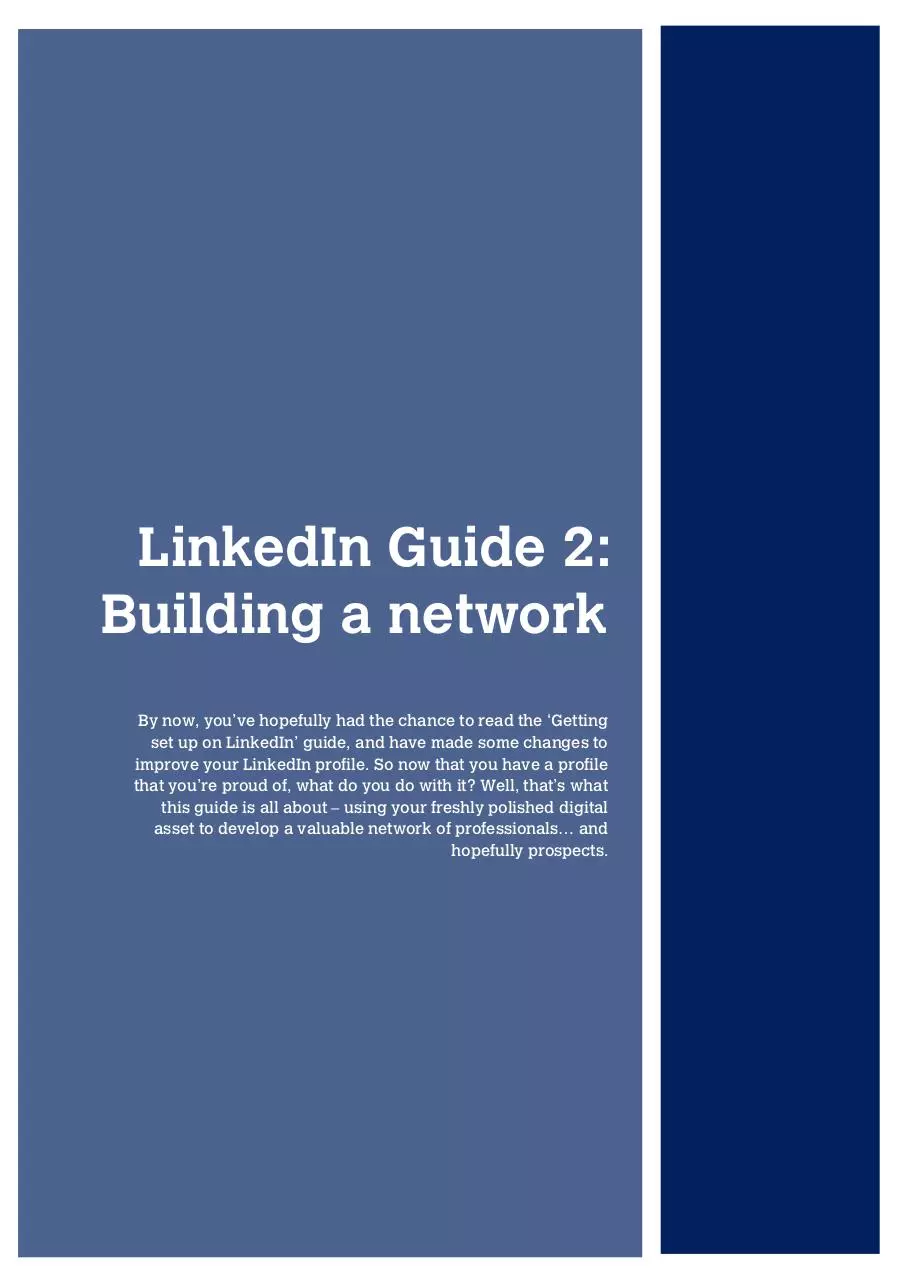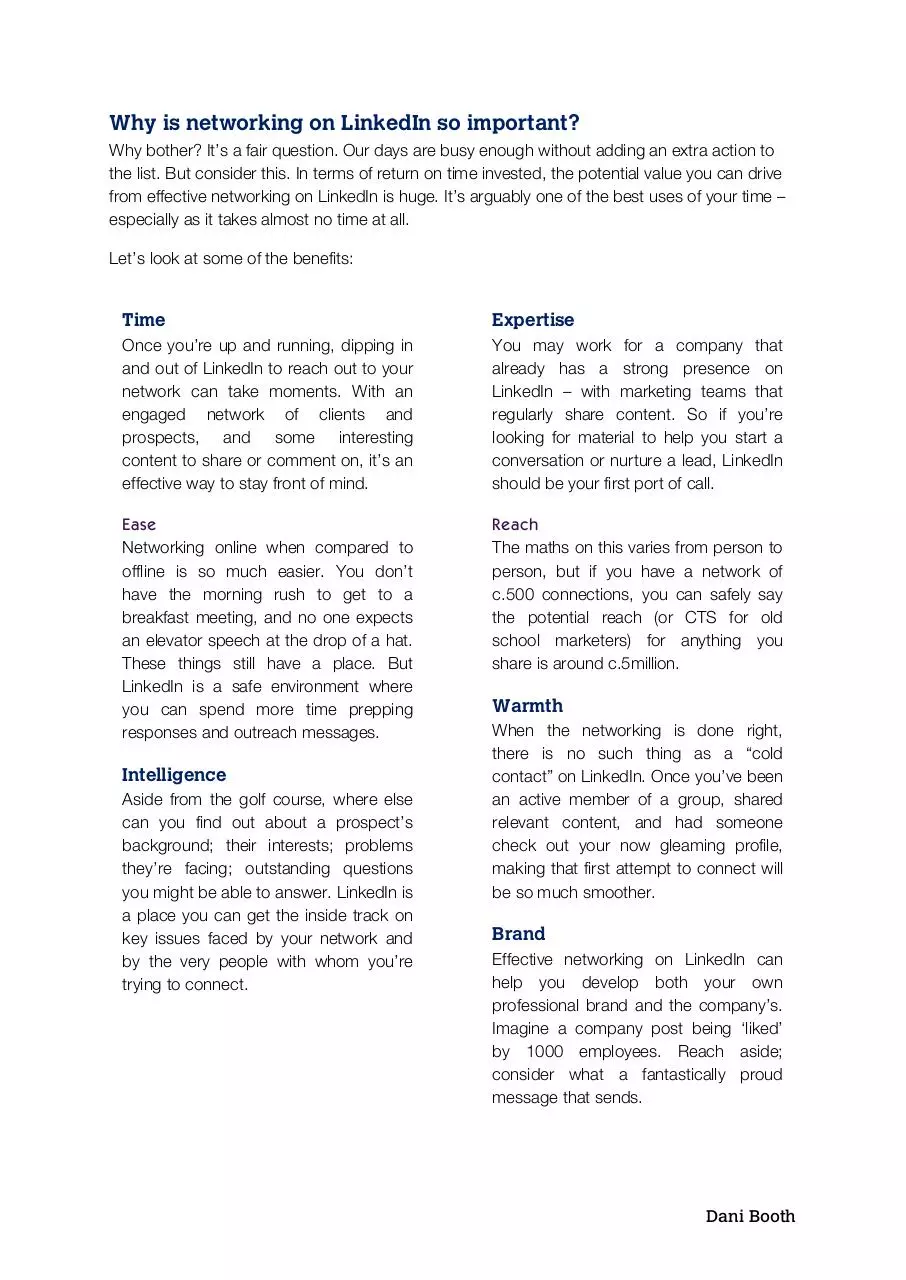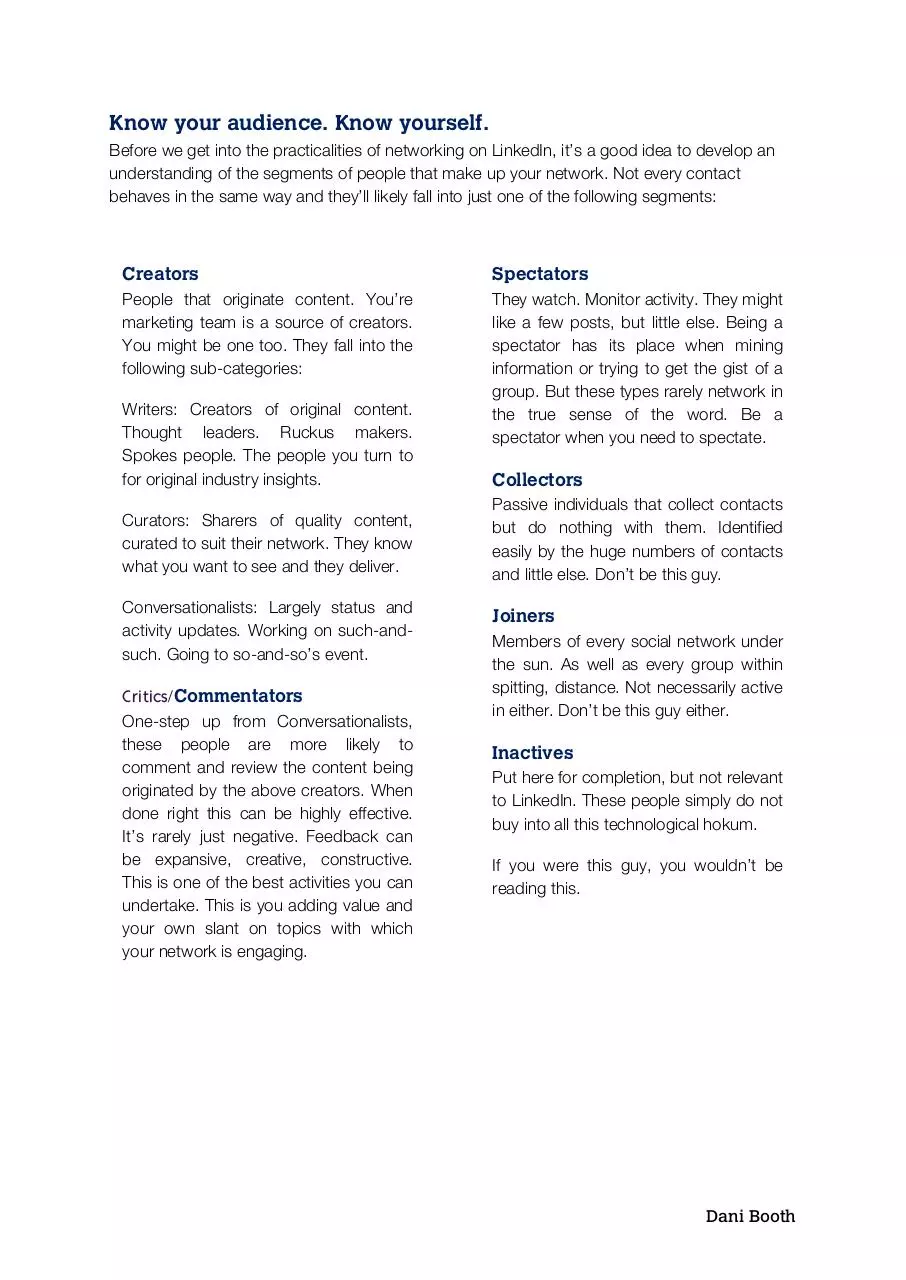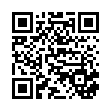Developing a valuable LinkedIn network (PDF)
File information
Title: LinkedIn Guide 2:
Author: Dani Booth
This PDF 1.5 document has been generated by Acrobat PDFMaker 10.1 for Word / Adobe PDF Library 10.0, and has been sent on pdf-archive.com on 11/08/2015 at 22:12, from IP address 92.236.x.x.
The current document download page has been viewed 560 times.
File size: 164.84 KB (7 pages).
Privacy: public file





File preview
LinkedIn Guide 2:
Building a network
By now, you’ve hopefully had the chance to read the ‘Getting
set up on LinkedIn’ guide, and have made some changes to
improve your LinkedIn profile. So now that you have a profile
that you’re proud of, what do you do with it? Well, that’s what
this guide is all about – using your freshly polished digital
asset to develop a valuable network of professionals… and
hopefully prospects.
Dani Booth
Why is networking on LinkedIn so important?
Why bother? It’s a fair question. Our days are busy enough without adding an extra action to
the list. But consider this. In terms of return on time invested, the potential value you can drive
from effective networking on LinkedIn is huge. It’s arguably one of the best uses of your time –
especially as it takes almost no time at all.
Let’s look at some of the benefits:
Time
Expertise
Once you’re up and running, dipping in
and out of LinkedIn to reach out to your
network can take moments. With an
engaged network of clients and
prospects, and some interesting
content to share or comment on, it’s an
effective way to stay front of mind.
You may work for a company that
already has a strong presence on
LinkedIn – with marketing teams that
regularly share content. So if you’re
looking for material to help you start a
conversation or nurture a lead, LinkedIn
should be your first port of call.
Ease
Networking online when compared to
offline is so much easier. You don’t
have the morning rush to get to a
breakfast meeting, and no one expects
an elevator speech at the drop of a hat.
These things still have a place. But
LinkedIn is a safe environment where
you can spend more time prepping
responses and outreach messages.
Reach
The maths on this varies from person to
person, but if you have a network of
c.500 connections, you can safely say
the potential reach (or CTS for old
school marketers) for anything you
share is around c.5million.
Intelligence
Aside from the golf course, where else
can you find out about a prospect’s
background; their interests; problems
they’re facing; outstanding questions
you might be able to answer. LinkedIn is
a place you can get the inside track on
key issues faced by your network and
by the very people with whom you’re
trying to connect.
Warmth
When the networking is done right,
there is no such thing as a “cold
contact” on LinkedIn. Once you’ve been
an active member of a group, shared
relevant content, and had someone
check out your now gleaming profile,
making that first attempt to connect will
be so much smoother.
Brand
Effective networking on LinkedIn can
help you develop both your own
professional brand and the company’s.
Imagine a company post being ‘liked’
by 1000 employees. Reach aside;
consider what a fantastically proud
message that sends.
Dani Booth
Know your audience. Know yourself.
Before we get into the practicalities of networking on LinkedIn, it’s a good idea to develop an
understanding of the segments of people that make up your network. Not every contact
behaves in the same way and they’ll likely fall into just one of the following segments:
Creators
Spectators
People that originate content. You’re
marketing team is a source of creators.
You might be one too. They fall into the
following sub-categories:
They watch. Monitor activity. They might
like a few posts, but little else. Being a
spectator has its place when mining
information or trying to get the gist of a
group. But these types rarely network in
the true sense of the word. Be a
spectator when you need to spectate.
Writers: Creators of original content.
Thought leaders. Ruckus makers.
Spokes people. The people you turn to
for original industry insights.
Curators: Sharers of quality content,
curated to suit their network. They know
what you want to see and they deliver.
Conversationalists: Largely status and
activity updates. Working on such-andsuch. Going to so-and-so’s event.
Critics/Commentators
One-step up from Conversationalists,
these people are more likely to
comment and review the content being
originated by the above creators. When
done right this can be highly effective.
It’s rarely just negative. Feedback can
be expansive, creative, constructive.
This is one of the best activities you can
undertake. This is you adding value and
your own slant on topics with which
your network is engaging.
Collectors
Passive individuals that collect contacts
but do nothing with them. Identified
easily by the huge numbers of contacts
and little else. Don’t be this guy.
Joiners
Members of every social network under
the sun. As well as every group within
spitting, distance. Not necessarily active
in either. Don’t be this guy either.
Inactives
Put here for completion, but not relevant
to LinkedIn. These people simply do not
buy into all this technological hokum.
If you were this guy, you wouldn’t be
reading this.
Dani Booth
Networking opportunities
Now that the benefits have been established and you know with whom you’re networking, how
do you actually… network?
Start a conversation
An “All-Star” profile only gets you so far. The way most people will get to your profile is through
the activities you undertake. Conversations you start. Content you post. Questions you ask. It’s
important to be active. But being active doesn’t necessarily take up much of your time.
Depending on how much time you have, here are some small, medium and large options:
Small: Content curation
Large: Publishing
Hopefully your marketing team is
already busy creating quality content to
inform and entertain your clients. This
content is regularly posted to LinkedIn.
All you need to do to be a content
curator is choose the posts most
relevant to your audience, or to the
conversations you’re already having
with clients, and hit ‘share’ (‘like’ the
post too for good measure). This
content is then shared via your profile to
your network.
Want to go all out and have your own
voice heard. Fantastic. LinkedIn’s
publishing platform is the perfect
environment for you to publish your own
articles and insights designed to help,
inform and entertain your network. And
once published, it’s forever present on
your LinkedIn profile, further polishing
your digital presence.
Medium: Content commentary
If you want to take your involvement in
content curation up a notch, be a
content commentator. When sharing
content as above, write your own take
on the topic being covered and add
value and insight to the discussion. You
might simply pull a key statistics from
the post. You may want to reference
how the subject affects your regions or
specific companies that you work with.
Adding value in this way is a great
conversation starter.
If you do want to become a publisher,
your first port of call should be to check
in with your marketing team. Not only
can they give you insights and guidance
on how to get the most out of the
publishing platform, but also they can
check what it is you intend to post, and
check that it doesn’t clash or duplicate
anything already underway.
Dani Booth
Explore existing communities
Having something interesting to say on a regular basis is half the battle. Finding an audience to
be interested in what you have to say is the other, arguably easier part of the puzzle. Aside
from the connections you make along the way, the two main places you’ll find people to
interact with are:
Companies
Groups
Makes sense right? The people you
want to network with are employees or
business owners. Most will have a
company page. Some might even use it
to post updates and tell their company’s
story. This is your opportunity to
become part of the conversation.
Groups are interesting.
A quick win here is playing to the needs
of the company you are following by
sharing their updates. This gives them
extra reach and demonstrates how
supportive you are of what they’re
doing. A great conversation starter.
If you can find groups that focus on the
specific sectors in which you operate –
ones that may even include involvement
from the people and organisations you
are targeting – then you have yourself
the inside track on the key issues
affecting the people that matter most…
clients and prospects.
Good groups are an amazing
environment for lively debates on key
industry issues, personal development
and all sorts of other topics. We want
you to be members of good groups.
Part of your success here will be in
identifying a good group. The other is
about listening to the conversations
taking place and participating in them…
not just posting your content and
hoping it becomes the next viral
sensation (see below “bad group”).
Posting content is fine, so long as
you’re adding value to a conversation,
answering a question, or using content
to expand on a topic already in debate.
Bad groups aren’t moderated and
quickly become another channel where
people dump their latest blog post with
little thought for their audience and no
interaction whatsoever.
So how do you identify a good group?
Cue the technical bit
Dani Booth
Identifying good groups
Have you found a group you want to get involved in? Follow these steps to check it’s worth
your while.
1.
2.
3.
4.
Navigate to the group home page
Click the cog icon that lives next to the member button
In the drop down click on group statistics
Hit the “Activity” tab and you’ll be presented with the below screen
A discussion is someone starting a new thread by either asking a question or posting a piece of
content. A comment is someone else commenting on said discussion. If you have many more
discussions that you have comments, there is little to no interaction with the group, which
means little or no conversations are taking place. That’s a bad group.
If however, you have a close ratio between discussions and comments, what you should find is
that people are engaging with the content and questions being posted. Lots more for you to
listen to and interact with. A good group.
Dani Booth
Further develop your profile
And finally, following on from the last guide; let’s first take a further look at your profile and the
networking opportunities it presents…
Recommendations
Projects
Proud of your work? Think you made an
impact? Ask for some feedback in the
shape of a recommendation. This is
similar to the skills section but because
it takes more effort than simply clicking
a button, it’s so much more valuable.
And it’s a great way of building a
network of links showing whom you’ve
worked with and what they thought of
your work.
What projects are you proud of? Who
made up the project team? What did
you produce? The projects section of
your profile is a great way of networking
with colleagues new and old –
celebrating the projects you have
worked on together while at the same
time presenting your collective efforts to
anyone visiting either profile. Done right,
this can lead to valuable new
connections and introductions.
And it’s a two way street. As a rule of
thumb for every three recommendations
you write, you’ll get one back. But don’t
let this shape your efforts. Only write a
recommendation if you mean what you
say. The things you write about others
say as much about you as the
recommendation you receive.
Volunteering
This section simply allows you to
articulate the types of causes you
support and, if applicable, how you are
involved
with
certain
charitable
organisations. Which is a great way of
connecting like-minded individuals.
Publications
Have you had your work cited? Have
you been quoted? Are you a regular
contributor to a blog or forum? Using
the publications section you can build a
portfolio of links showing which
publications you have worked with
including a link to the content. This is
great for embellishing your profile with
real life examples and a great
conversation starter.
Dani Booth
Download Developing a valuable LinkedIn network
Developing a valuable LinkedIn network.pdf (PDF, 164.84 KB)
Download PDF
Share this file on social networks
Link to this page
Permanent link
Use the permanent link to the download page to share your document on Facebook, Twitter, LinkedIn, or directly with a contact by e-Mail, Messenger, Whatsapp, Line..
Short link
Use the short link to share your document on Twitter or by text message (SMS)
HTML Code
Copy the following HTML code to share your document on a Website or Blog
QR Code to this page

This file has been shared publicly by a user of PDF Archive.
Document ID: 0000294697.